Clarity AI: A New Paradigm for Mineral Exploration
on Mon Sep 22 2025
Francis Doumet
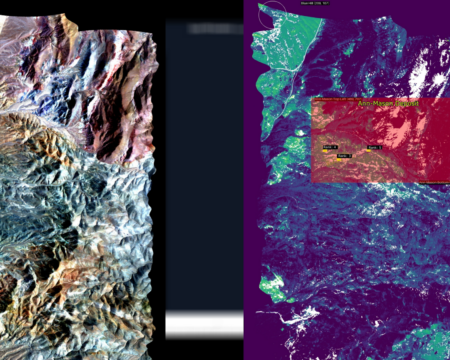
The global demand for critical minerals is surging, yet discovering new deposits remains a monumental challenge. It’s a process that has traditionally relied on decades of geological expertise, painstaking fieldwork, and expensive, speculative drilling. Hyperspectral imagery offers incredible detail and promise, but its sheer volume can be overwhelming. Exploration teams sift through mountains of geological data, searching for subtle clues buried in complex datasets.
What if, instead of spending weeks manually processing data, you could simply ask it where to find what you’re looking for?
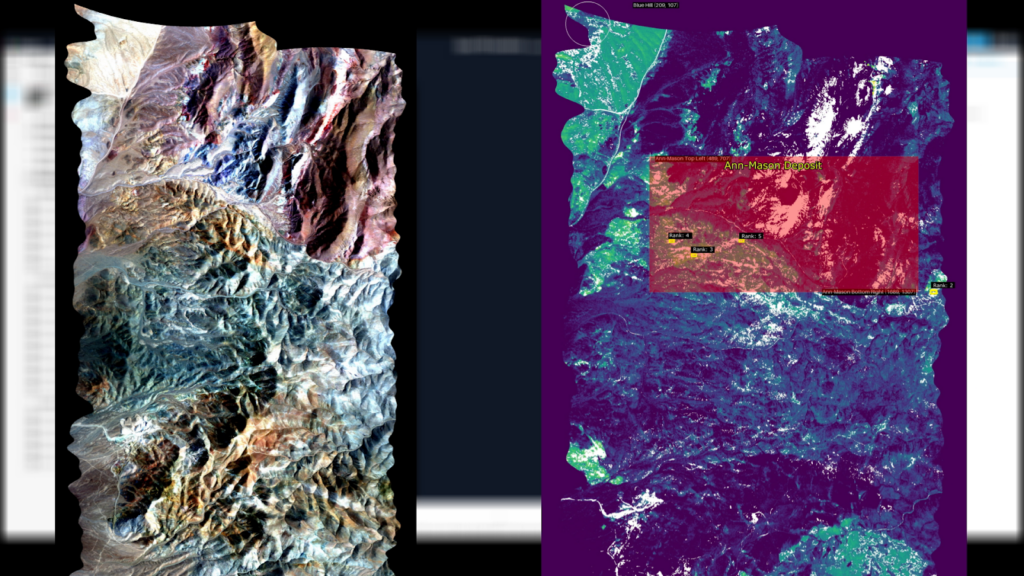
Today, we’re showcasing Clarity AI, a new hyperspectral assistant available on our Clarity platform. Clarity AI is designed to accelerate the entire data science workflow. It can help build and explore datasets, train models, analyze performance, and conduct deep research. For this demonstration, we gave it a hyperspectral image and an associated mineralogy dataset over Yerington, Nevada, provided by our partners at SpecTIR, and asked, “Where should I look in my image to mine copper?”
From a Single Question to a Strategic Playbook
Instead of blindly processing pixels, Clarity AI formulates its strategy through a rigorous, three-part process that mirrors an expert researcher’s workflow.
First, it establishes the mission, defining the core objective, the available data, and what a successful outcome looks like. This initial step is like creating a project brief, ensuring the entire analysis is aligned with the end goal.
Second, it performs data reconnaissance. By examining the dataset’s technical specifications and contextual metadata, the AI not only assesses its quality but also identifies its real-world location. In this case, it recognized the scene was Yerington, Nevada—a critical finding that allowed it to tailor its subsequent research and create a geologically relevant plan.
Finally, it applies domain knowledge. The AI consults its knowledge base as well as scientific literature, searching for relevant scientific principles and successful analytical workflows. By combining the project goals with the data’s specific properties and a foundation of proven research, it formulates a complete, multi-phase action plan, which it then presents to the user as a transparent, step-by-step strategy. For this analysis, it delivered the following 4-phase plan:
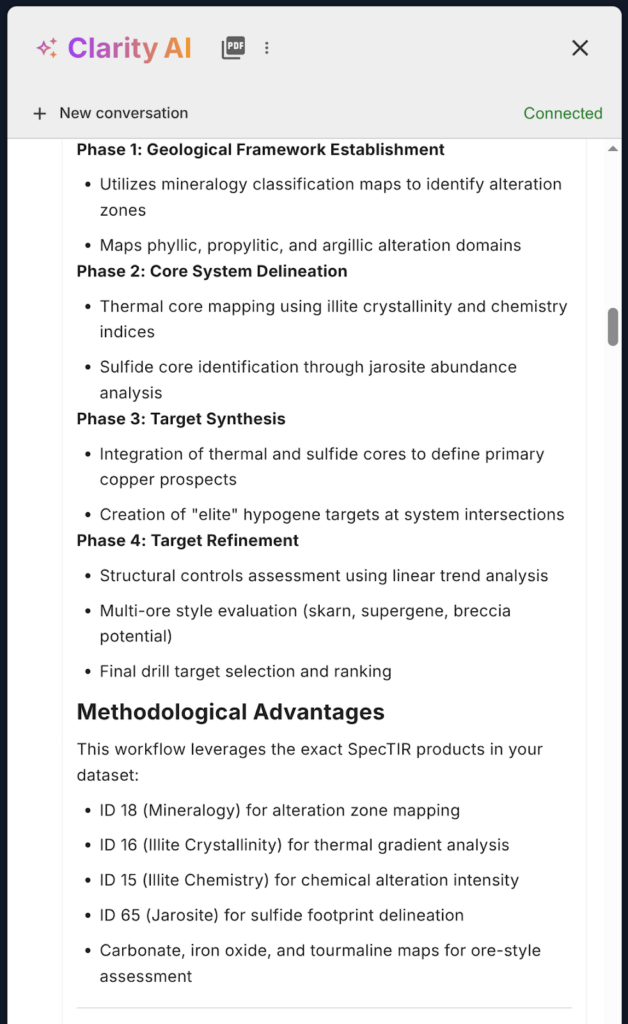
A Transparent Workflow. Before executing any analysis, Clarity AI presents a detailed, multi-phase workflow. This screenshot illustrates its plan, covering everything from geological framework establishment to final target refinement, ensuring a transparent and verifiable exploration strategy using specific SpecTIR data products.
The Core Analysis: Executing the Four-Phase Plan
With the plan established, Clarity AI began the main analysis. It systematically executed its four-phase workflow, using the specific SpecTIR data products to hunt for the key signatures of copper mineralization.
Phase 1: Geological Framework Establishment
First, the AI confirmed the area’s geology matched the known characteristics of the Yerington district. It examined the mineralogy maps to identify and outline the large-scale alteration zones—the chemical footprints left by ancient hot fluids. The analysis revealed a classic pattern: a hot, acidic phyllic zone (rich in the mineral illite) at the center, surrounded by a cooler propylitic zone (rich in chlorite). This spatial arrangement, like concentric rings around a bullseye, provided the definitive geological fingerprint of a large-scale copper deposit.
Phase 2: Core System Delineation
The agent then utilized its image processing pipeline to map the two key components of the system:
- The Thermal Core: This is the “heat engine” of the deposit. By performing an illite crystallinity analysis on the data—a process that acts like a “fossil thermometer”—the AI identified the hottest parts of the ancient system. Critically, it didn’t just find one hot spot; it located a primary thermal core in the northwestern part of the image, plus multiple secondary centers. This revealed a complex, multi-phase system, a key insight for exploration.
- The Sulfide Core: This is the chemical “sulfide trap” that causes valuable metals to drop out of the hot fluids. By isolating the unique spectral signature of the mineral jarosite, the AI mapped this feature. Jarosite acts as a surface “rust stain,” indicating where a large sulfide body (the original pyrite halo) is located below.
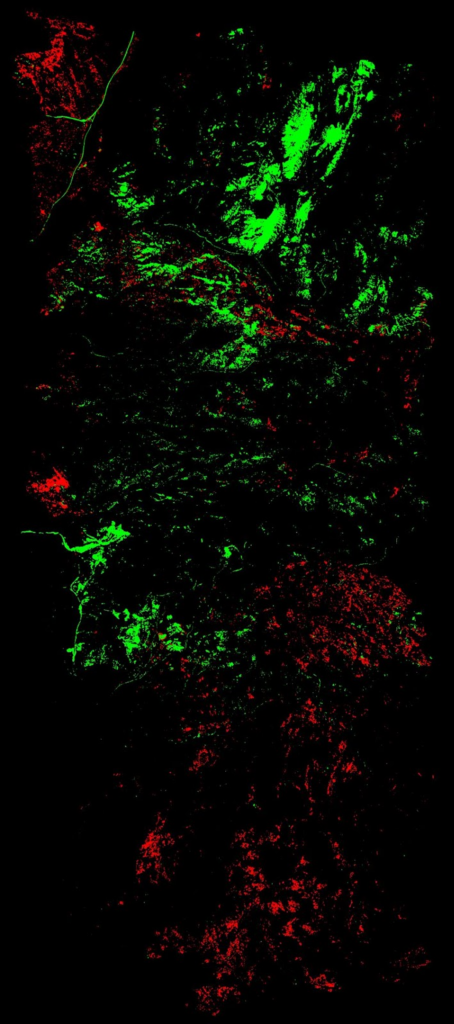
Thresholded Geochemical Systems. Clarity AI maps the Thermal Core (red) using illite crystallinity thresholds and the Sulfide Core (green) using jarosite abundance thresholds. This separation is the critical step before performing a logical intersection to identify target zones.
Phase 3: Target Synthesis
This is where the key ingredients came together. Clarity AI performed a crucial synthesis by digitally layering the Thermal Core and Sulfide Core maps. It then executed a logical intersection to identify the exact locations where the heat engine and the sulfide trap overlapped. These geochemical “reaction fronts” represent the most favorable zones for high-grade copper to have formed, creating a primary map of high-potential prospects.
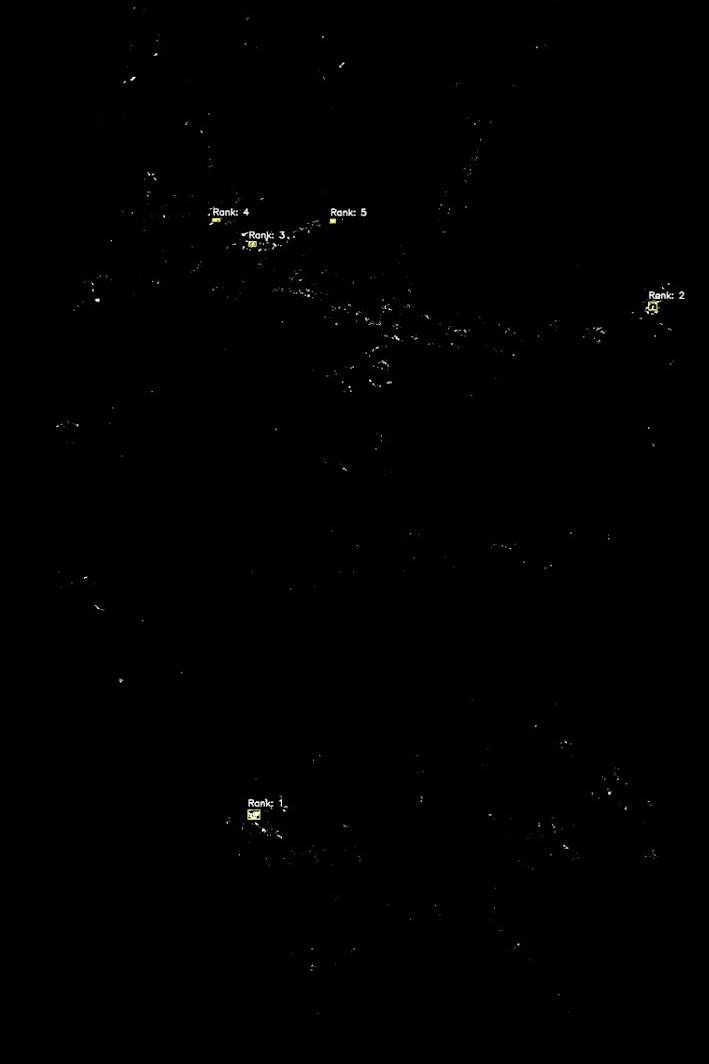
Clarity AI’s Initial Copper Prospects. The primary high-potential targets (yellow boxes) identified by Clarity AI. These represent the precise “reaction fronts” where the heat engine and sulfide trap systems overlap, highlighting zones most favorable for copper mineralization.
Phase 4: Refining and Ranking the Targets
The final phase was about fine-tuning the initial prospects. To do this, the AI performed several additional analyses to validate its findings. It first examined the area’s structural controls by analyzing the rock’s faults and fractures, which confirmed the initial targets were well-positioned. It then performed its due diligence on other ore styles: it checked for skarn potential using carbonate maps and assessed supergene enrichment using iron oxide ratios, finding both to have limited potential, as is often expected for the Yerington district. Finally, it explored the possibility of breccia pipes by mapping tourmaline concentrations. The key takeaway was the AI’s methodical process, layering multiple geological tests to increase confidence in the final results.
The Ultimate Validation: Hitting the Mark
We asked Clarity AI to overlay the locations of known, historically significant mineral deposits on its final target map. Clarity AI’s highest-ranked targets were located directly within or adjacent to the known Ann Mason copper deposit, a major copper resource in the district. The agent had independently rediscovered a known deposit by applying first-principles geological science through its advanced analytical pipeline.
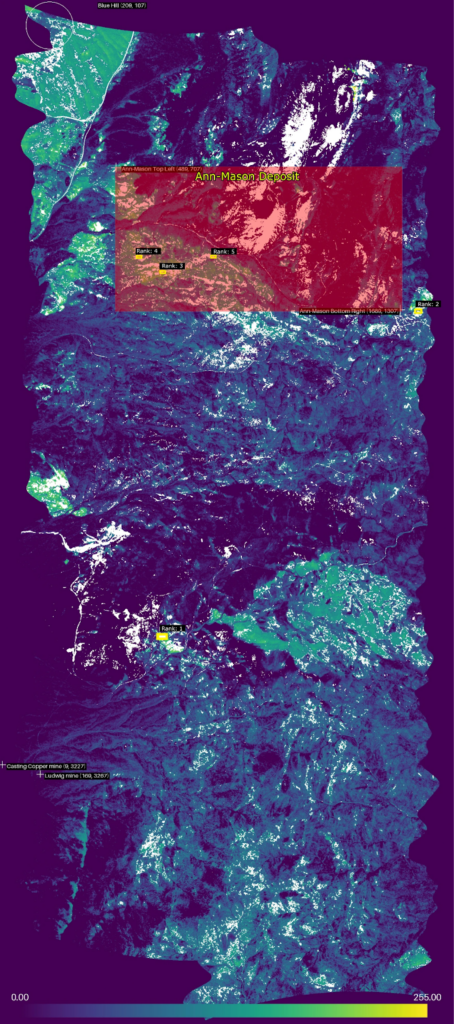
Clarity AI’s Final Targets Validated. Clarity AI’s final target map showing top-ranked prospective mining locations, derived from the precise “reaction fronts” where thermal and sulfide cores intersect. As a key validation, these AI-generated targets fall directly within the known Ann Mason Deposit, highlighted in red.
See a full video of Clarity AI in action here.
A Collaborator to Jumpstart Research
The success of this structured workflow was significantly enhanced by Clarity AI’s ability to act as a research collaborator from the outset. Before launching the full, multi-step analysis, this initial dialogue allowed us to quickly get familiar with the complex dataset. We could ask the agent to isolate specific minerals, visualize their distribution, and test initial hypotheses in real-time. This interactive process jumpstarted our research, allowing us to build confidence in the data and the analytical plan before committing to the intensive workflow.
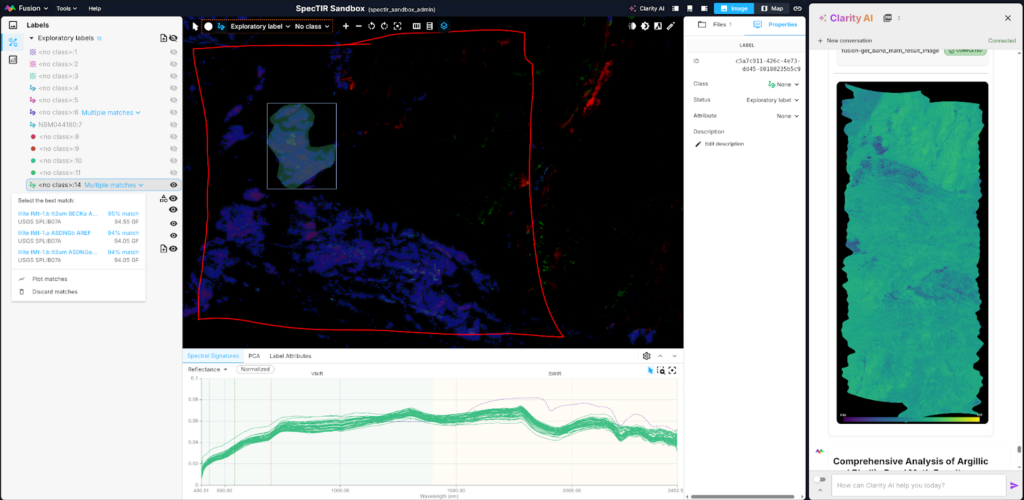
Unlocking Insights with Clarity AI in Spectral Explorer. Clarity AI (right) collaborates with a user in the Spectral Explorer interface (left). The AI has proactively assisted in the generation of various band math indices (e.g., “Advanced Argillic Alteration” and “Phyllic Alteration Enhancement”) and is performing analysis by thresholding and overlaying. The user is also exploring the results in the central pane. The far-left pane further displays material identification results, demonstrating how Clarity AI rapidly translates raw spectral data into actionable geological insights.
The Future of Discovery is Conversational
Metaspectral’s Clarity AI transforms our relationship with data. It integrates deep domain knowledge with on-the-fly research to construct and execute the precise workflow needed to solve a problem. It turns passive data exploration into an active, collaborative dialogue, accelerating discovery and allowing users to hone in on what’s most valuable.
This analysis in the Yerington district is just one example. The same collaborative, knowledge-driven approach can be applied to countless challenges in agriculture, environmental monitoring, defense, and beyond. We are at the beginning of a new era of data analysis—one where the deepest insights are just a conversation away.
Explore the future of hyperspectral analysis. Join the waitlist for Clarity AI today.
